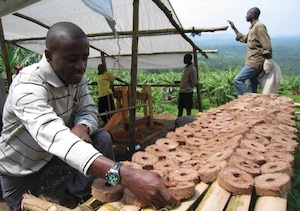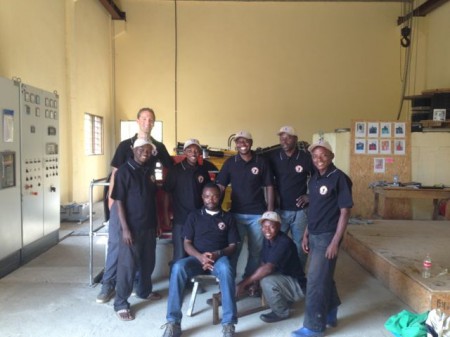Green energies to preserve a World Heritage site
Национальный парк Вирунга расположен в центре конфликта, и по обе стороны границы посредники ДРК, Руанда и Уганда. Домой к некоторым из последних оставшихся в мире горных горилл,это Африка первый национальный парк, a World Heritage Site and is known to contain more species ofmammals, птиц и рептилий, чем любой другой охраняемой территории на планете.
В период после геноцида в Руанде, 15 лет вооруженного конфликта в восточной части Конго создан один из самых серьезных гуманитарных трагедий в новейшей истории. Конфликт по поводу природных ресурсов является основной причиной вооруженного конфликта. Незаконный оборот лесных ресурсов, в частности уголь, provided armed groups with one of their primary sources of income. По 70,000 tons of charcoal is illegallyproduced every year. Thisrepresents the destruction ofover 15,000 hectares of tropicalhardwood forest.
Производство брикетов:
альтернативный источник топлива вокруг Вирунга
A 2008 study of the charcoal market in Goma by the African Conservation Fund estimated that 59,000 tonnes were consumed each year, with 80% coming from Virunga.
In these circumstances, the Village Briquette Factories project provided a viable solution to replace the consumption of charcoal in the region with a viable and sustainable alternative, тем самым предотвращая массовое уничтожение лесов в Вирунга. Combustible biomass briquettes are an ecologically sustainable fuel source available to households living in extreme poverty. They aresignificantly cheaper than charcoal and can be produced from a verywide range of abundant resources including grass, leaves, agriculturalwaste, sawdust and recycled paper.
The expected impact of the project should be of 34,000 sustainable employments. Полные комплекты заводе, состоящий из необходимого оборудования, обучение, поддержка и гарантированный выкуп производства будет уделяться 5,000 команд 6 люди. Брикет производителей может генерировать достаточно средств, чтобы прокормить свои семьи в течение 10 дней с момента их 2-дневный тренинг.
Устойчивое финансирование национального парка Вирунга. The Village Briquette Factories will be developed as a high yielding business model. Прибыль будет частично реинвестируется в дальнейшее развитие программы, и частично используется для покрытия значительной части текущих расходов национального парка Вирунга.
The project is complementary to another project started by WWF in 2008, aimed to tackle illegal charcoal production in Virunga in ways that would benefit local people. It has established local production of efficient stoves to cut the use of charcoal, and helped to start small plantations to supply wood for charcoal production on a sustainable basis.
This project is a true model of international cooperation. The pilot programme for the Village Briquette Factories was funded by the European Union, The African Conservation Fund (Великобритания) the US Fish and Wildlife Service, theBritish Foreign and Commonwealth Office, the Daey Ouwens Fund, the Belgian Ministry of Foreign Affairs, UNESCO/Région Wallone, Government of Germany, the World Wide Fund for Nature (WWF), the Greater Virunga Transboundary Collaboration/government of the Netherlands and several private donors.
Hydro power to develop Virunga
A hydro-electric project using water run-off from the park’s Ruwenzori Mountains has been finalised in 2013. This has allowed Virunga to have an electricity grid for the first time.
The facility has an installed capacity of 400 kW to serve the people of Mutwanga near Virunga’s northern sector headquarters, and has the potential for increased economic development in the region and start ensuring access to electricity. The revenue that will be generated by the Mutwanga hydroelectric plant is also a big first step on the path toward helping the park fund operations even when tourism is closed by conflict.
Climate change is a complex issue which..
The implementation of an arduous campaign was central to the success of the Briquettes Programme. В 2009 there were 500 presses in production, generating over 4000 sacks of briquettes a month, with over 3000 people involved in that production. Assembling a team of trainers and business advisors, and build a very effective logistics, finance and administrative support system were necessary to drive the project forward.
The creation of the Renewable Energy and Efficient Technology Center has been a major supporting measure. A growing number of businesses and households are turning away from charcoal as a result.

















